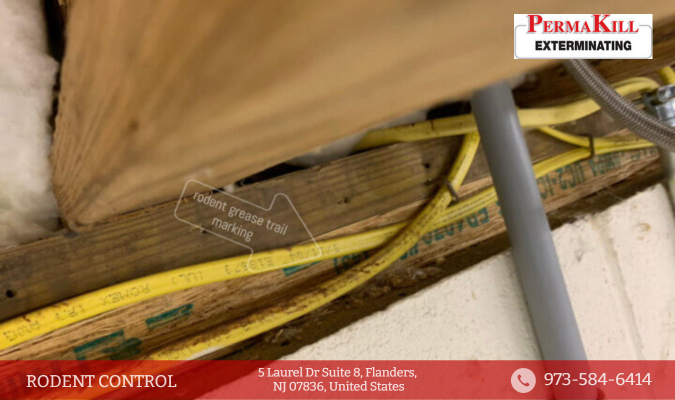


Rat infestations are a common issue across the country, with some cities like Chicago topping a list of the most rat-infested places in the US. Roof rats are one of the three common rodents that invade homes, aside from Norway rats and house mice. Despite their name, roof rats aren’t just found on roofs: you can also find them nesting within your walls.
So how do you get rid of roof rats in your walls? You have to look for signs of any rat activity, learn their habits, and make sure the rat colony doesn’t have access to food, water, heat, or shelter.
Any infestation of roof rats needs to be tackled with a variety of different methods to ensure that you get rid of the infestation and prevent another one from happening. With a combination of preventive measures and active management, you can reasonably get rid of roof rats without too much trouble.
Roof rats are resourceful and agile, even if you compare them to house mice or Norway rats. If you find signs that a colony has settled in your walls, you need to act fast to get rid of them before the rats multiply.
This is the most significant factor that leads to roof rat infestations: a readily accessible food source. Areas that are vulnerable to roof rat invasion are usually food pantries or poorly secured cabinets that are attached directly to your wall, allowing roof rats easy access to the food inside.
There are several ways you can tackle this problem:
Roof rats are omnivorous – meaning they’ll eat almost anything – but they’re particularly fond of fruit, seeds, and other garden produce. If you’re fond of stocking fruit baskets in your pantry or kitchen, move them to the fridge or secure them inside a container.
Like most rodents, roof rats are creatures of habit: once they’ve established their favorite paths, they’ll keep using them. Aside from being simple ways to spot the signs of a roof rat infestation, these areas are also great for setting glue traps and other rat removal tools.
Keep in mind that this method is only a stopgap measure: given enough time, roof rats will pass through different areas and nest in different places. Trapping their frequently traveled routes will not get rid of the infestation itself.
Roof rats like making their nests in the upper reaches of the house such as the attic, where they can be warmed by rising heat. However, this also means that they can settle in places above in-wall heating, especially if you have brittle drywall and plaster that they can chew through. If you’re trying to identify where a potential roof rat nest is, check for the warmest areas in your house.
It’s also possible that the nest is located outside your property. External heating vents that are near trees, shrubs, or bushes can be excellent nesting sites for roof rats. Large and old trees near homes are some possible nesting sites. Aside from a nest, trees and bushes can also function as food sources for roof rats, since they will snack on nuts and berries if given the chance. They can also burrow close to the ground if it’s near a heating vent.
Aside from food, roof rats also need a reliable source of drinking water to establish a colony. This can be anything from unattended pails and basins to indoor pools and water features. The rainy season can be a particularly encouraging time for roof rats to breed as they seek shelter indoors, away from the rain, and within the heating.
Do a thorough sweep of any containers or places where water can pool. Areas that you should check include:
You should also check for leaky pipes, condensation from air conditioning, or excess moisture from your bathroom.
While you can manage and even remove small enough infestations of roof rats by yourself, sometimes a colony will be too big or too embedded inside your house to remove without compromising yourself or the structure of your home. In cases like these, calling a professional is your only option.
Not only will a pest removal company have the tools needed to tackle large infestations, but they’ll also have the expertise to identify weak points and other gaps where roof rats can exploit. They can also give you recommendations on how to manage other pest problems on your own and recommend solutions to prevent similar infestations from happening again.

Roof rats are usually nocturnal, which can make identification quite difficult. However, they leave traces of their activities that you can spot during the day.
If you see unusual grease marks, smudges, or trails during your weekly cleaning, they’re likely a sign of roof rats. Roof rats will often establish the nearest likely route to any potential food source from their nest, so you can easily detect their pathing if you clean around your kitchen often enough.
You can also check for teeth marks or scuff marks on your walls and furniture. Roof rats are excellent climbers and will often shimmy along staircases, hanging cabinets, and large refrigerators to get to and from their nests. Check for any tracks above cabinets, shelves, or tabletops, especially if they’re places you rarely dust. Any paths used by roof rats will show up immediately, especially if they’ve used them for a while.
Roof rats can measure anywhere from 7 to 10 inches fully grown, so they make a fair amount of mess and noise when they move around. If you’re awake during the evenings, you should be able to hear them in the walls, ceiling, or near the attic as faint thudding or scratching noises. If they’re trying to burrow above your heating, you should also hear steady yet faint scraping from the mid-afternoon to late evening.
It's easy to confuse roof rat noises with other noises in your vicinity, so you need to be extra sure that it is rodent activity and not the usual noises caused by electrical systems or your plumbing. A good way to check is to tap or knock near or directly on the area where a noise is coming from; if it suddenly stops, there’s a likely chance that you’ve just spooked a rat.
If you have pets, they may be able to pick up the signs of a roof rat before you do. Pets like dogs have a particularly strong sense of hearing, which can hear rats from inside the walls. If you own pets that start acting erratically or seem like they’re trying to hear something you don’t, it may be a sign of roof rats.
Another frequent sign of roof rats is odors and droppings, especially around your food. This usually means that there’s a large enough colony that they feel comfortable leaving their droppings in the open, or your food source is right next to their nests. Most rat roof infestations also come with a distinct, rotting asparagus-like smell near their frequently traveled trails and nesting sites.
Holes are also a clear sign of a roof rat infestation, especially if it’s near warm areas of your home. Roof rats can squeeze through relatively tiny holes, so you need to keep your eyes peeled if you think you have an infestation. These holes may not always lead to their nesting sites, but they can give you a general idea of where to look and trap.
You can get rid of an active roof rat infestation fairly quickly, but that doesn’t prevent them from returning if your home isn’t rat-proofed. To prevent future infestations from happening in your house, there are two things you should do:
Dirty homes are an ideal environment for any rodent, especially roof rats. Since they thrive in conditions where they can easily nest, feed, and move around, keeping your surroundings clean is one of the most effective ways to prevent any rodent infestations inside your home.
Aside from regular sweeping, vacuuming, and mopping, make it a habit to check for nesting sites in the nooks and crannies of your property, especially near vents, empty spaces above or behind your walls, in your attic, or near any place where there’s an excess of ambient heat. If you have a central heating system, have it checked and maintained at least twice a year to prevent any moisture from seeping into the surroundings.
Remember that rats don’t need a path of entry into your home: they can chew, burrow, and claw their way inside with no trouble. That’s why you should also check if there are some weak structural points around your home, like rotting wood or exposed piping.
Another change that you can make is by making regular appointments to have your home maintained or swept for any potential weak points. Roof rats can get in through plumbing, electrical outlets, ventilation shafts, and any other entry or exit point in your house. Be mindful of how often you leave your windows and your doors open. You should also check the ground near your home for any entry points, especially if you have a large garden.
If you aren’t confident about how protected your property is against roof rats, you can always hire a pest control or rat extermination company to check for you.
Sometimes it’s easy to underestimate the danger that roof rats cause, especially if you’ve just caught the beginnings of a colony in your home. But roof rats can quickly become an enormous problem if you leave them unattended and can cause some serious issues in your household.
Roof rats are significant health and safety hazards since they can carry diseases like salmonella, toxoplasmosis, and leptospirosis. Given their preferred proximity to your food, they can easily transmit any viruses or bacteria to your food, even if they haven’t chewed or taken a bite out of it.
There’s also them bringing in other pests with them like lice or ticks, which can latch on to pets or children in your home. These bugs are difficult pests to remove, especially once they’ve gained entry into your home through the roof rats.
Roof rats prefer warm places to make their nests, usually inside heating units in the wall or attic. This puts your wiring or furnishings at risk since they can chew or dig through your electrical wiring and drywall to build a nest. With a large enough colony, they may cause electrical systems or outlets in your property to stop working.
This on top of the damage that they may already cause when digging inside your walls, especially if they’re coming from the outside. The holes can create drafts and other unsecured airflow channels, which can affect your heating and water bill.
If you’re suspecting that roof rats have settled in your home, call PermaKill Exterminating to eliminate them before they grow into a large colony. Our expert technicians have an innate understanding of rodent behavior (including house mice, Norway rats, and other outdoor rodents), ensuring that we remove any colonies before they get too out of hand.
Contact PermaKilll Exterminating today for an on-site consultation to identify and solve any potential rodent problems you may have.
Learn more: What Do Rat Droppings Look Like?